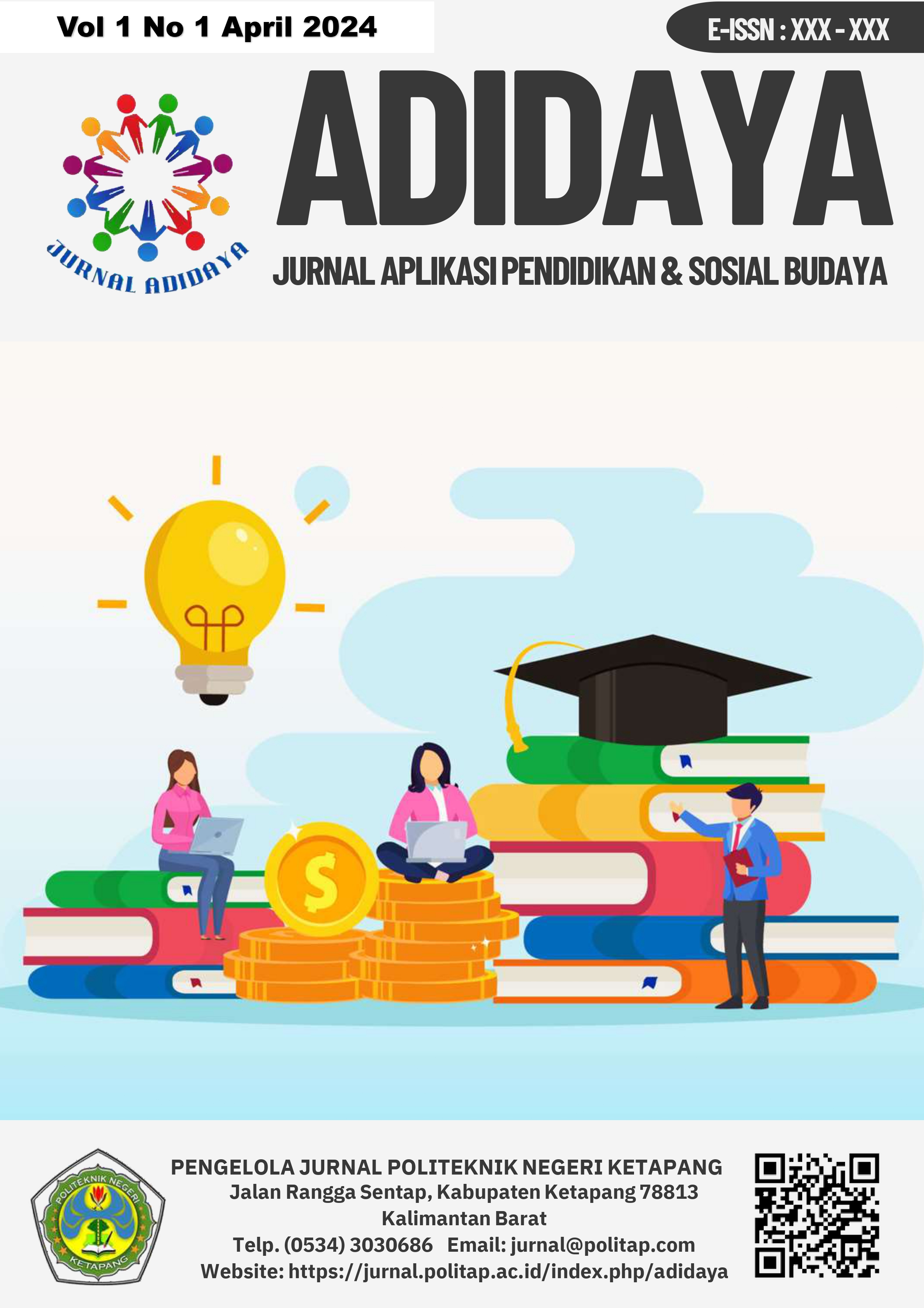PERSEPSI SISWA TENTANG PENGGUNAAN MEDIA DALAM PEMBELAJARAN BAHASA INGGRIS
DOI:
https://doi.org/10.58466/adidaya.v1i1.1474Keywords:
Students ‘Perception, Media, Teacher, Teaching English,Abstract
The role of media in the learning process is crucial, serving as a key component for effective communication between teachers and students. Without media, this communication process would be hindered, leading to ineffective learning outcomes. To assess the effectiveness of teachers' creativity in utilizing instructional media, it is essential to consider students' perceptions and observations. This study aimed to analyze students' perceptions of the media employed by English teachers at SMP Al-faqihil Muqaddam. Utilizing a qualitative descriptive methodology, the researcher investigated students' responses to the instructional media through observation and interviews. The findings revealed that the media utilized by English teachers included a whiteboard, English book, dictionary, laptop, LCD projector, and speaker. The students' interviews yielded predominantly positive perceptions of the media used in the teaching and learning process. According to the students, the use of media resulted in increased engagement, excitement, and active participation in learning English. They found the materials easier to comprehend, improved their pronunciation and vocabulary, generated new ideas, and felt empowered to express their opinions. Furthermore, they appreciated the practicality of applying what they learned in their daily lives. In conclusion, this research sheds light on the importance of utilizing various media in English language instruction and highlights the positive impact it has on students' learning experiences. By understanding students' perceptions, educators can tailor their instructional approaches to enhance engagement and comprehension, ultimately fostering a more effective learning environment.
References
Azikiwe. (2007). Instructional Media for Effective Teaching and Learning. Nigeria: Ahmadu Bello University Zaria Nigeria.
Angell, J. (1906). An Introductory Study of the Structure and Function of Human Conscious. New York: Henry Holt and Company.
Arsyad, Azar. (2003). Media Pembelajaran. Jakarta: King Grafindo Persada.
Gagne, R., Briggs, L. (1970). Principles of Instructional Design (4th Ed). Fort Worth, TX: HBJ College Publisher
Gay. L. R. (1981). Educational Research. New York: Charles E. Merrill
Publishing Company.
Hermer, J. (2009). The Practice of English Language Teaching (4t Ed) Harlow: Longman.
Kemp, Jerold E. (1977). Instructional Design. Belmont, California: David S.Lake Publisher.
Latuheru, John. D. 1988. Instructional Media and Today Learning Process.Jakarta: Dekdikbud Dirjen Dikti Proyek Pengembangan Lembaga Pendidikan Tenaga Pendidikan.
Malika, H. (2007). Persepsi Siswa terhadap Model Pembelajaran Sejarah
Menggunakan Media Film Dokumenter pada Siswa Kelas VIII SMP Negeri 36 Semarang (Metode Kualitatif Deskriptif). Semarang: Fakultas Ilmu Sosial. Universitas Negeri Semarang.
Miles, B. Mathew and Michel Huberman. (1992). Qualitative Data Analysis.Jakarta: UIP.
Morris, B. (1962). The Function of Media in the Public School. Audio Visual Instruction, 8 (9), 9-14.
Murcia, M. C. (2001). Teaching English as a Second or Foreign Language, Third Edition. United States of America. Heinle & Heinle.
Nurjannah, T. (2018). The Students’ Perception Towards the Methods Used by the Teachers in Teaching English at SMA Negeri 13 Pangkep (Descriptive
Research). Makassar: Thesis of Thesis of FKIP Unismuh Makassar. Oxford English Dictionary. (2007). Learner‟s Pocket Dictionary 7th ed. Oxford: Oxford University Press, 2007.
Omenge, R. O., Priscah, J. M. (2016). Understanding the Utilization of
Instructional Media in Training Health Professionals. Department of Community Health: Egerton University.
Reza. (2016). Students’ Perception on the Use of Movie Media in Language English Teaching at Islamic University of As-Syafi'iyah. Sumatra.
Rohani, Ahmad. (1997). Media Instructional Educatif. Jakarta: PT. Rineka Cipta
Robbin. (1995). Increasing Students' Engagement and Motivation. Educational Northwest.
Ruis, N. (2009). Instructional Media. Jakarta: Ministry of National Education.
Seth, O. K. (2000). Instructional Media as a Tool for Ensuring Quality Teaching and Learning for Pupils in the Junior High Schools (Selected Schools in the Kumasi Metropolis). Thesis for Master PG1131507 Department of General Art Studies.
Sudjana, N and Rivai, A. (1992). Media Pembelajaran. Bandung: Penerbit CV. Sinar Baru Bandung.
Smith, D. Barry. (1998). Psychology Science and Understanding. New York: MC Grau. Hills Companies.
Smith, C. (1945). Phenomenology of Perception. London and New York: Gallimard, Paris.
Sulastiani. (2018). The Students’ Perception of Lecturers’ Characteristics in Classroom Teaching at the English Lectrures of Faculty of Teachers Traning and Education in Unismuh (Descriptive Study). Makassar: Thesis of Thesis of FKIP Unismuh Makassar.
Suleiman, Amir Hamzah. 1985. Media Audio-Visual for Teaching. Jakarta: PT Gramedia.
Wang, Yingxu. (2007). On the Cognitive Processes of Human Perception with Emotions, Motivation and Attitude. Journal of Cognitive Informatics and Natural Intelligence, 1 (4), 1-3.
Walgito, Bimo. (1989). Pengantar Psikologi Umum. Surabaya: Bina Ilmu. Zaden, James. W Wander. (1984). Social Psychology. New York: Random House.








 This journal has been indexed by:
This journal has been indexed by:

